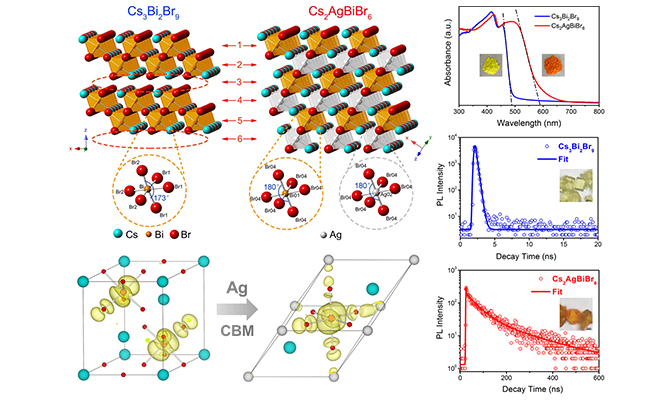
Metal halide perovskites have triggered great interests due to their unique properties such as high optical absorption coefcient, low exciton binding energy, and high carrier mobility. They are promising in various optical and electronic fields.
However, why perovskite-structured materials exhibit excellent photoelectric properties and how the unique crystalline structures affect the charge separation and transport properties remain unclear.
Recently, the research groups led by Prof. LI Can and Prof. LI Rengui from the Dalian Institute of Chemical Physics (DICP) of the Chinese Academy of Sciences (CAS) investigated the structural modulation and photoelectric properties of perovskite materials.
They revealed that the elimination of octahedral distortion within the all-inorganic lead-free halide perovskite reduced the localization of electron-hole pairs, enhanced the separation and transport of photogenerated charges, and exhibited excellent photoelectric properties.

Understanding the effect of crystalline structural transformation for lead-free inorganic halide perovskites (Image by SHI Ming and LI Rengui)
Scientists used inorganic halide perovskite Cs3Bi2Br9 as a prototype. Furthermore, they formed double perovskite Cs2AgBiBr6 by introducing Ag atoms into the structure to replace part of Bi atoms.
Compared to Cs3Bi2Br9, Cs2AgBiBr6 exhibited smaller exciton binding energy, lower effective carrier mass, higher carrier mobility and effective lifetime. It greatly improved the separation and transport of photogenerated charges.
They further used the photocatalytic hydrogen production reaction under visible light as a probe reaction and found that the modulation of the perovskite microstructure increased the photocatalytic hydrogen production activity by more than two orders of magnitude.
They also verified the important effect of perovskite structure modulation on photogenerated charge separation and transport properties.
This study helps to understand the essential relationship between the microstructure of perovskite semiconductors and their photoelectric properties, as well as the rational design of new perovskite material systems in photoelectric fields.
The research was published in Advanced Materials. It was supported by the National Natural Science Foundation of China, the Strategic Priority Research Program of Chinese Academy of Sciences and Liaoning Revitalization Talents Program.

86-10-68597521 (day)
86-10-68597289 (night)

52 Sanlihe Rd., Xicheng District,
Beijing, China (100864)

